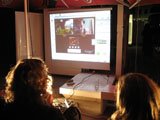Pssst! top secret...
Dear Ursula,compared to the last Transmediale , which was still meditating over the question whether there is such a thing as media art at all, the Transmediale 08 at least committed itself to a more contemporary approach to this topic:
In his introduction speech, Stephen commented on the question of a journalist ("but there's a painting in the exhibition. How can this be media art?") with a simple statement. He said, that the Transmediale commissions and selects works that reflect on the conditions of today's networked media, regardless of their materiality or mediality. And even the representative of the German Federal Cultural Foundation, who normally need to "categorize" art forms in order to match them with the respective funding program, did her best to avoid the label "media art".
Yet still we discuss this question of how to curate digital art forms, especially netart, in this blog. And I think it is worthwhile to keep this discussion going. Because of a very simple reason: I still come across many media-based exhibitions which either leave the audience under- or overchallenged.
"Underchallenged" in that context means the mere reduction to media (re)presentation in an exhibition space, without a dedicated strategy to mediate the artworks.
And sometimes I feel "overchallenged" when I see curatorial approaches with ambition and spirit, but which nonetheless fail to provide an entry point for the viewer. And this brings me to the extreme tricky balance between the information about the work and the work itself (which should always speak for itself, of course).
The "Conspire"-exhibition of this year's Trandmediale was discussed very controversely among the people I know. Most of them agreed that the general approach was conspirative indeed, introverted, maybe even a statement of separatism. And the motto of course reflects on the conspirative scene of digital art connaisseurs, too.
Others objected that most of the visitors had no chance to understand the works, as there was a significant lack of background information. Not even the catalogue, which accompagnied the exhibition as an independent publication, provided much insight into the works of art.
And for some of the works this was simply a pity. My friend Alice Miceli, an artist from Rio de Janeiro, showed some photos of her ongoing "Chernobyl project". The problem was that the photos were presented like x-rays in a doctor's cabinet, thus suggesting a specific context which in my opinion did not match the aims of her project. There was possibly no chance to fully provide an idea of her really complex and intelligent research by just displaying some photos.
Apart from that, there have been other artistic contributions which really provoked the question a) what they were all about and b) in what way they refered to "conspiracy" at all.
I can't see what's wrong with presenting background information as an addition to the artist's work. In my opinion, this brings a new dimension to the work: creating a platform for discourse, questions and exchange should be part of an exhibition, too.
I think that a clever mediation strategy also increases the visibility of the curator's work. For me, the essentials of curating lie not only in the selection of art pieces within a certain thematic framework, but also in sharing the passion and interest one has for a specific issue.
Somebody once suggested, that curators have the role of "meta-artists"...well, I am not sure about this. Whether this makes sense or not: what is a meta-artist anyways, do we want or need that?
By the way, I want to take this opportunity to make some cross-promotion to our latest collaboration, the Tabu project at the Theater am Neumarkt in Zürich / Switzerland. Dear blog readers, please check the tabu blog and make your contributions - in whatever language you like...
Greetings from Berlin,
Ela

